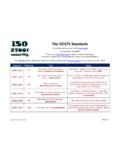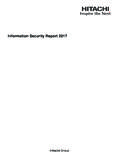Transcription of NIST SP 800-145, The NIST Definition of Cloud Computing
1 4/10/13 Final Version of NIST Cloud Computing Definition Published NIST Time NIST Home About NIST Contact Us A-Z Site Index Search About ITL Publications Topic/Subject Areas Products/Services News/Multimedia Programs/Projects NIST Home > ITL > C omputer Security Division > Final Version of NIST C loud C omputing Definition Published Final Version of NIST Cloud Computing Definition Published From NIST Tech Beat: October 25, 2011. Select Language *. Pow ered by Translate Contact: Evelyn Brown 301-975-5661. After years in the works and 15 drafts, the National Institute of Standards and Technology's (NIST) working Definition of Cloud Computing , the 16th and final Definition has been published as The NIST Definition of Cloud Computing (NIST Special Publication 800-145).
2 Cloud Computing is a relatively new business model in the Computing world. According to the official NIST Definition , " Cloud Computing is a model for enabling ubiquitous, convenient, on-demand network access to a shared pool of configurable Computing resources ( , networks, servers, storage, applications and services) that can be rapidly provisioned and released with minimal management effort or service provider interaction.". The NIST Definition lists five essential characteristics of Cloud Computing : on-demand self-service, broad network access, resource pooling, rapid elasticity or expansion, and measured service. It also lists three "service models" (software, platform and infrastructure), and four "deployment models" (private, community, public and hybrid) that together categorize ways to deliver Cloud services.
3 The Definition is intended to serve as a means for broad comparisons of Cloud services and deployment strategies, and to provide a baseline for discussion from what is Cloud Computing to how to best use Cloud Computing . "When agencies or companies use this Definition ," says NIST computer scientist Peter Mell, "they have a tool to determine the extent to which the information technology implementations they are considering meet the Cloud characteristics and models. This is important because by adopting an authentic Cloud , they are more likely to reap the promised benefits of Cloud cost savings, energy savings, rapid deployment and customer empowerment. And matching an implementation to the Cloud Definition can assist in evaluating the security properties of the Cloud .
4 ". While just finalized, NIST's working Definition of Cloud Computing has long been the de facto Definition . In fact before it was officially published, the draft was the contribution to the InterNational Committee for Information Technology Standards (INCITS) as that group worked to develop a standard international Cloud Computing Definition . The first draft of the Cloud Computing Definition was created in November 2009. "We went through many versions while vetting it with government and industry before we had a stable one." That one, version 15, was posted to the NIST Cloud Computing website in July 2009. In January 2011 that version was published for public comment as public draft SP 800-145.
5 Researchers received a large amount of feedback, which mainly dealt with interpretations. The Definition from draft to final remained substantively the same and only a modest number of changes were made to ensure consistent interpretations. The NIST Definition of Cloud Computing (SP 800-145) is available at #800-145. The National Institute of Standards and Technology (NIST) is an agency of the Department of C ommerce. Privacy Policy / Security Notice / Accessibility Statement / Disclaimer / Freedom of Information Act (FOIA) / Sign Up for NIST E-mail alerts: Environmental Policy Statement / No Fear Act Policy / NIST Information Quality Standards / Enter email address Go Scientific Integrity Summary Date created: October 25, 2011 | Last updated: October 25, 2011 C ontact: Webmaster 1/1.
6 Special Publication 800-145. The NIST Definition of Cloud Computing Recommendations of the National Institute of Standards and Technology Peter Mell Timothy Grance NIST Special Publication 800-145 The NIST Definition of Cloud Computing Peter Mell Timothy Grance C O M P U T E R s e c u r i t y . Computer Security Division Information Technology Laboratory National Institute of Standards and Technology Gaithersburg, MD 20899-8930. September 2011. Department of Commerce Rebecca M. Blank, Acting Secretary National Institute of Standards and Technology Patrick D. Gallagher, Under Secretary for Standards and Technology and Director Reports on Computer Systems Technology The Information Technology Laboratory (ITL) at the National Institute of Standards and Technology (NIST) promotes the economy and public welfare by providing technical leadership for the nation's measurement and standards infrastructure.
7 ITL develops tests, test methods, reference data, proof of concept implementations, and technical analysis to advance the development and productive use of information technology. ITL's responsibilities include the development of technical, physical, administrative, and management standards and guidelines for the cost-effective security and privacy of sensitive unclassified information in Federal computer systems. This Special Publication 800-series reports on ITL's research, guidance, and outreach efforts in computer security and its collaborative activities with industry, government, and academic organizations. National Institute of Standards and Technology Special Publication 800-145.
8 7 pages (September 2011). Certain commercial entities, equipment, or materials may be identified in this document in order to describe an experimental procedure or concept adequately. Such identification is not intended to imply recommendation or endorsement by the National Institute of Standards and Technology, nor is it intended to imply that the entities, materials, or equipment are necessarily the best available for the purpose. ii Acknowledgements The authors Peter Mell and Timothy Grance of the National Institute of Standards and Technology (NIST) would like to thank the many experts in industry and government who contributed their thoughts to the creation and review of this Definition .
9 We especially acknowledge Murugiah Souppaya and Lee Badger, also of NIST, and Wayne Jansen of Booz Allen Hamilton, whose advice and technical insight assisted this effort. Errata The following changes have been incorporated into Special Publication 800-145, as of the date indicated in the table. DATE TYPE CHANGE PAGE NUMBER. 4/27/2012 Editorial Corrected page number from 2 to 1 1. iii 1. Introduction Authority The National Institute of Standards and Technology (NIST) developed this document in furtherance of its statutory responsibilities under the Federal Information Security Management Act (FISMA) of 2002, Public Law 107-347. NIST is responsible for developing standards and guidelines, including minimum requirements, for providing adequate information security for all agency operations and assets; but such standards and guidelines shall not apply to national security systems.
10 This guideline is consistent with the requirements of the Office of Management and Budget (OMB) Circular A-130, Section 8b(3), Securing Agency Information Systems, as analyzed in A-130, Appendix IV: Analysis of Key Sections. Supplemental information is provided in A-130, Appendix III. This guideline has been prepared for use by Federal agencies. It may be used by nongovernmental organizations on a voluntary basis and is not subject to copyright, though attribution is desired. Nothing in this document should be taken to contradict standards and guidelines made mandatory and binding on Federal agencies by the Secretary of Commerce under statutory authority, nor should these guidelines be interpreted as altering or superseding the existing authorities of the Secretary of Commerce, Director of the OMB, or any other Federal official.




